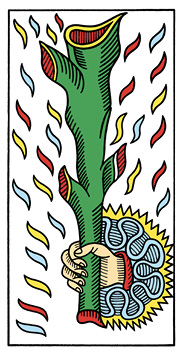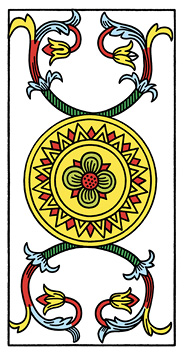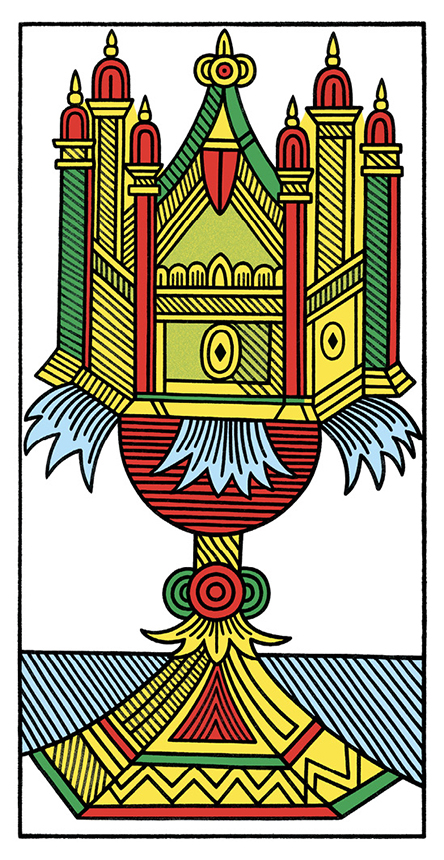The Ace Cards
Each minor suit begins with an ace card that presents the suit symbol as a large image rich in details. In ordinary card games, an ace card can have two values: it can be both the lowest and the highest card in the suit. In much the same way, the tarot ace card has a double function in the suit. On one hand, the ace is number one, the beginning of the suit. On the other hand, the ace represents the suit symbol in its most developed form, and thus it summarizes the nature of the entire suit.
In a reading we can interpret an ace card in both ways. As number one, the ace card expresses the beginning of a process or a new initiative related to the suit domain. For example, the Ace of Coins may be a new business venture, and the Ace of Wands can indicate the beginning of a creative project. As the card that summarizes the whole suit, an ace can symbolize an attitude or a significant factor expressing the character of the suit. For example, the Ace of Cups may represent a sentimental and romantic attitude that motivates the querent, while the Ace of Swords may describe a cerebral attitude, a cutting decision, or the act of focusing on a goal.
As mentioned in the previous chapter, various mystical and magical traditions employ the idea of a symbolic quartet that represents four aspects of some wholeness. The function of the ace card as representing the energy of the suit makes it possible to take it out of the deck and use it as an emblem or amulet representing one element of the quartet. For example, we can set up a magical circle for a ritual or a focusing and visualization session by laying around us the four ace cards in the four directions corresponding to the suits. We can also perform an exercise in which we focus on one of the ace cards in order to strengthen our inner forces in the corresponding suit domain. We can also make a copy of the ace card and carry it with us, and so on.




The Four Aces: Wands, Cups, Coins, and Swords

The three other aces present objects that stand upright, but the coin appears as if it is lying flat on the ground. According to Jodorowsky, this expresses the more basic nature of the coins relative to the other suits. The coin is the ground from which the other suits grow, just as the material reality is the basis of all life functions: without a body, there is no place for desire, emotion, or intellect.
The four-petaled flower at the center of the coin may signify the structure of the complete tarot deck. The circle in the middle represents the major suit, and the four petals are the minor suits. The round coin may also symbolize the Earth as it was thought of in ancient times: a flat and round plate, but marked by the four cardinal directions. In alchemy and astrology the symbol of the Earth is a circle divided into four equal quadrants, which represent the four material elements: earth, fire, water, and air. In traditional Western magic it is also customary to perform rituals within a circle around which the four cardinal directions are marked.
The Ace of Coins thus can be considered as containing within it the potential for growth, not only for its own suit but for the other suits as well. The plant decorations above and under the coin are still turned inside, but they seem to be ready to open and might hint at the suit of wands, the next suit in the order of evolution. The aspect of growth is also reflected by the presence of the number three: three lines on each petal of the central flower and three kinds of triangles in the external part of the coin.
The Ace of Coins is almost symmetrical in the vertical axis, meaning there is only a minor difference between the straight and the inverse position. For example, in the upper right-hand side the flower isn’t completely painted, the space above the coin is a little larger than the space under it, and the pattern of dots at the center of the coin looks different when the card is inverse. Still, as the basic structure is the same, usually we do not distinguish between a straight and an inverse card. This may express the neutral nature of money and matter: both have an objective measure (for example, in kilograms or dollars) that does not depend on our moral preferences. Therefore, we cannot speak about them as good or bad by themselves.
interpretation: The beginning of a business or an economic venture. Devoting attention and effort to material matters, such as bodily health, property, the workplace, or the living space. A stable and solid base for future growth. A practical attitude that remains close to the ground and to tangible matters. Materialistic considerations. A significant sum of money appearing in the querent’s life.

The base of the cup in the card illustration looks as if it is emerging from a water-covered surface, and the whole image gives the impression of pushing upward. The three jagged shapes in light blue at the middle of the card may be streams of water pouring from the cup or perhaps wings carrying it up to the sky. The vertical structures at the upper edges resemble the towers of a fortified city or a religious structure, like a cathedral. They are pointing to the sky or to heaven, but they also fall short of actually touching the card frame. We can see here an aspiration to grow out of the material realm and reach something beyond ordinary reality, an aspiration that can never be fully realized.
In the Christian tradition a liquid-holding cup appears in various places as a symbol of a mystical aspiration or of sanctity, such as the chalice of holy wine or the grail of Arthurian legend. But the receptacle on the card looks rather like a reliquary of the kind used to keep relics of Catholic saints. In Judaism a similar shape can also be found in Havdalah receptacles, which contain perfumes and are used to separate the sacred time of the Shabbat from worldly existence.
The suit of cups represents the domain of emotions and love. The religious element in the card’s design may express the idea of earthly love as a reflection of heavenly love. In other words, love and devotion toward God are a higher aspect of similar feelings shared between human beings. This idea plays an important part in mystical currents of many religions, such as Christianity, Judaism, and Hinduism. We can find another hint connecting earthly love with the divine realm in the Lover card from the major suit.
There are differences between the left and the right side of the cup, especially a difference in the shading, which makes the right side more open and illuminated. Still, generally speaking, the card looks fairly symmetrical and schematic, with straight lines and square angles. This may seem strange for a card that is supposed to represent emotions. Indeed, in some other traditional decks, the cup shape looks softer and rounder. One possible explanation is that the objects of the other three suits can be used alone as they stand. In contrast, the cup is only a receptacle that serves for something else, namely the liquid it contains. In a similar way, we may think that the ace card does not represent emotion itself, which is subtle and intangible. Rather, it symbolizes the human structures that provide space for emotion and love, such as a family or a couple relationship.
interpretation: A new love. Intimacy, mystery, the warmth of hidden feelings. Focusing on romantic affairs or on emotional issues. Yearning for someone who is absent or longing for something unattainable. A romantic, spiritual, or idealistic attitude. Feelings of mystery. Devotion and submission to something beyond yourself.
inverse: Negative feelings, an emotional block, misguided aspirations, a deception in romantic matters.

The ace cards of the two hard suits show a hand coming out of a strange yellow-tipped shape and holding the suit symbol. Both aces also contain colored drops that give the cards an energetic, vibrant, and bursting character. But in the Ace of Wands the grip is gentler than in the Ace of Swords, with the soft and accepting side of the hand turned toward us. One may understand that the Ace of Wands has a softer nature, which is also expressed in the illustration of the wand.
In the Rider-Waite deck the Ace of Wands has a strong masculine aspect, with a clear phallic shape of the central object, but in the Tarot de Marseille the wand shape has a double nature: it is both a stick and a tube, meaning that it is both masculine and feminine. The lower part of the wand is straight and upright, and it stresses the masculine aspect. In the upper part the external lines of the wand are soft and rounded, and the tip shows an opening that is suggestive of a female sexual organ.
The green wand becomes wider in its upper part, expressing vitality and growth. The drops spreading at the sides signal an outgoing flow. These aspects emphasize the relation of the suit to creativity, desires, and life force. The cut stubs of the branches may seem like blood drops, but their shape is also similar to the colorful drops surrounding the emblem. We can interpret them as initiatives in various directions that do not lead to long-term achievements (meaning they are cut off), but they still inspire and generate a general atmosphere of energy and creation. This signifies the plentiful and extravagant nature of the life force, which spreads its resources in all directions. The evident fingernails express the process of struggling and coping with difficulties. On the stem above the severed branch on the right is a sort of hidden thorn, which may symbolize the dangers of an uncontrolled burst of passion.
When the Ace of Wands card is straight one can see it as a plentiful force of life, full of dynamic impulses, energy, and creativity. When the card is inverted the drops are converging and the wand, with its side branches, becomes narrow and squeezed between the fingers. In this position it can symbolize a block or a limitation of impulses and desires, especially in the sexual or creative domains. But it can also signify concentration that aligns impulsive drives toward a specific goal.
interpretation: A period of growth, drive, and energy; moving forward with passion. Start of a creative project or a generally creative period. Dissipation of resources in all directions. Active sexual life, a new partner, or multiple sexual affairs at once. An attempt to advance in different directions simultaneously, letting the results decide which one to follow in the long term. Acting on desire and impulse without thinking too much about the consequences.
inverse: Restriction, a creative block, lack of energy, repressed sexual drives.

The large sword rising through the middle of the card gives it a sharp and decisive character. The crown is decorated with two branches, which can be a palm on the right and a bay laurel on the left. Both are known since ancient times as common symbols of victory. The red tips of the cut branches resemble blood drops and may symbolize sacrifice and hard struggle through which victory is achieved. The crown can also refer to the head and highlight the suit’s link with the domain of intellect. A crown with two similar branches appears at the bottom of the 2 of Cups.
The irregular shape at the bottom left, from which the hand emerges, resembles a similar shape in the Ace of Wands card, but in the Ace of Swords the yellow serrated edge looks sharper and more angular and agitated. In addition, the hand is growing from the edge of the shape, while in the Ace of Wands it emerges from the center. This might express the intuitive feeling that impulses and desires originate in deep levels within our mind. In contrast, rationality and the intellect conform to laws that we learn and absorb from our environment. This means that they are felt as something external that we assimilate.
One can also see the wavy lines as a symbol of the brain. Today we know that impulses and desires come from central parts of the brain. In contrast, rationality and language are processed in the outer cortex. This means that passion and desires come “from inside,” while rational thinking is imposed “from the outside.” Clearly, the original creators of the tarot couldn’t have been explicitly aware of this fact, but they might have felt it intuitively. We can also note the difference between the natural, flowing wand and the artificial, rigid blade of the sword. Again, this may express the difference between passions and rationality.
When the card is straight one may think of the sword as being held in our hand. In such a situation the card can indicate a sharp and precise action, clear thought, efficient planning, or the ability to make an incisive decision. However, when the card is inverse we can think that the sword is being thrust into us. This may represent negative ideas and fixed preconceptions that hinder and damage the querent. Alternatively, it can indicate being hurt by someone. We can also see the inverse card as encouraging the querent to “turn the card around” and take deliberate and decisive action in order to change their situation.
interpretation: Sharp thinking; a clear definition of goals. Power and control of the situation. An ability to skip lengthy deliberations and decide one way or the other. Cutting away with the past, with negative influences, and so on. A fighting spirit, courage, victory, glory. A new initiative characterized by determination and precise planning. Separating between beneficial and damaging things. Ambition and competitiveness.
inverse: Confusion, negative thoughts, unproductive perceptions, self-punishment, cruelty, hurt, defeat.